Ijraset Journal For Research in Applied Science and Engineering Technology
- Home / Ijraset
- On This Page
- Abstract
- Introduction
- Conclusion
- References
- Copyright
Design of a Solar Electric Carriage Focused on Sustainable Tourism in the Historical Center of Popayán: A Case Study
Authors: Ana Maria Jimenez Santos, Katty Yohana Valencia Solis, Richard Marcelo Imbachi Chavez
DOI Link: https://doi.org/10.22214/ijraset.2024.62133
Certificate: View Certificate
Abstract
The world continues to experience constant growth, which requires innovative processes and products. The city of Popayán, especially its historic center, needs environmentally friendly means of transportation. This article presents an approach to the concepts of innovation, sustainability, road safety, road infrastructure, sociocultural aspects, and urban mobility. It proposes a redesign from an e-bike to an e-carriage for the historic center of Popayán, Colombia, as a sustainable innovation. This project involves a methodology based on research, studies, design processes, and prototyping, as well as the impacts generated by this model within the city, proposing a solution to the various challenges it faces.
Introduction
I. INTRODUCTION
Popayán, a Colombian city of great historical and cultural value (Bravo Molina, 2012), faces challenges regarding mobility and road safety in its historic center. These challenges, coupled with the pollution generated by conventional transportation, deteriorate the quality of life for the city's inhabitants and visitors (Urzúa M & Caqueo-Urízar, 2012). Sustainable tourism is an alternative to mitigate these impacts. However, transportation is a key factor for its development (Moreno & Coromoto, 2010); the use of electric vehicles is a promising option to reduce carbon footprint and improve mobility in Colombia (Montes Ochoa, 2023).
The historic center of the White City (Popayán) faces challenges in mobility and road safety, primarily due to a combination of factors such as the common transportation method called mototaxis, lack of zebra crossings for pedestrian crossing and priority, few traffic lights, etc. (Fajardo, H. C. L., & Gómez, S. A. M, 2015). The characteristics of the road infrastructure of the historic center were assessed, the mobility causes and problems were identified, and a relevant solution was proposed. It was determined that a major cause of the problem was the high vehicular traffic flow and the various types of pollution it generated. The deterioration of the energy matrix in conventional transportation was identified, affecting the quality of life of people who live and frequently transit this sector of the city, and a switch to solar energy was suggested. Transportation based on fossil fuel engines represents a supporting variable of the tourist and economic model in the city; globally, fossil fuels account for 80% of current primary energy demand (Valdés, 2021).
This article presents the design of a solar electric pedelec carriage (solar tourism e-carriage, "E-carriage ST") as an alternative for sustainable tourism in the historic center of Popayán. The prototype of the E-carriage ST was developed by the research group PI (Productivity and Innovation in Industrial Engineering) of the Fundación Universitaria de Popayán (FUP) and its research seedbed SIE2.
This document begins with a description of the study's context, presenting the mobility and road safety challenges in the historic center of Popayán, as well as the importance of sustainable tourism for the city. Next, the objectives and methodology of the study are described. The general objective of the study was to design a prototype of an e-carriage ST as a sustainable transportation alternative for downtown Popayán. The specific objectives were:
- Determine the characteristics of the road infrastructure in downtown Popayán.
- Design the most suitable e-carriage ST prototype.
- Determine the impact of the e-carriage ST prototype in downtown Popayán.
The hypothesis proposed is that the use of the e-carriage ST contributes to the strengthening of sustainable tourism in the historic center of Popayán.
The following presents the design of the E-carriage ST prototype. It is comprised of a frame, an electric motor, a battery, a solar panel, a controller, and an energy management system. As an adaptation to the cultural context of the area, a transportation model based on the Victorian carriage was proposed. Finally, the results of the study are presented, in which the E-carriage ST prototype is shown to be a viable alternative for sustainable tourism in the historic center of Popayán. The E-carriage ST has a positive impact on mobility and road safety, and contributes to the reduction of the carbon footprint.
II. THEORY AND CALCULATION
Next, the methodological process of this research is described: the 4 phases in which it was developed, the materials used for the final design, and the potential impact it could generate.
A. Methodology
The following phases were implemented to originate the design of the solar electric carriage:
- Analysis of the sociocultural context of the historic center of Popayán.
- Analysis of the road infrastructure of the historic center
- Design and prototyping of the e-carriage.
- Analysis of the potential impacts to be generated by the e-carriage on the socioeconomic model of the historic center of Popayán.
The following diagram #1 corresponds to the mentioned stages:
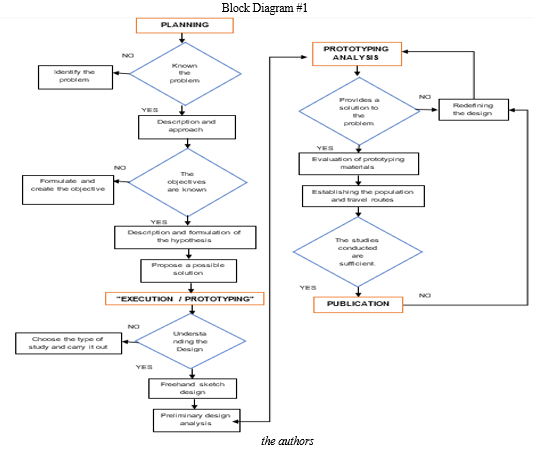
- Phase I: Analysis of the sociocultural context of the historic center of Popayán
In image #1, the sociocultural elements that make up the 'historic center of Popayán' are presented: 10 churches, 7 museums, 9 points of interest, 2 information points, 61 blocks.
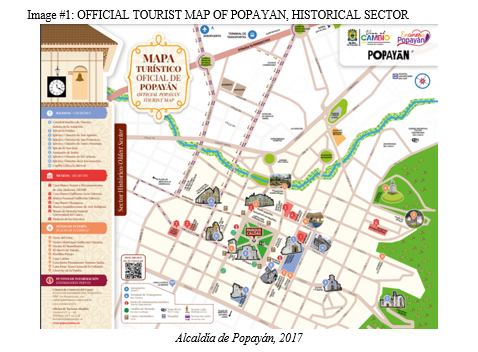
The tourist map of Popayan's historic center showcases various sites of interest, categorized into the following three classifications:
Churches
- Catedral Basílica de Nuestra Señora de la Asunción.
- Iglesia La Ermita.
- Iglesia y Claustro de San Agustín.
- Iglesia y Claustro de San Francisco.
- Iglesia y Claustro de Santo Domingo.
- Iglesia de San José.
- Santuario de Belén.
- Iglesia y Claustro de El Carmen.
- Iglesia y Claustro de la Encarnación.
- Capilla Gótica la Mercéd.
Museums
- Casa Museo Negret e Iberoamericano de Arte Moderno, MIAMP.
- Casa Museo Guillermo León Valencia.
- Museo Nacional Guillermo Valencia.
- Casa Museo Mosquera.
- Museo Arquidiocesano de Arte Religioso.
- Museo de Historia Natural - Universidad del Cauca.
- Panteón de los Próceres.
Sites of interest
- Torre del reloj.
- Teatro Municipal Guillermo León Valencia.
- Puente El Humilladero.
- El Morro de Tulcán.
- Pueblito Patojo.
- Casa Caldas.
- Casa Junta Permanente Semana Santa.
- Casa Jorge Isaacs (casa de la Cultura).
- Chorrito de la Pamba.
- Information Points
Cámara de Comercio del Cauca (Punto de información turística)
Oficina de Turismo Alcaldía.
In Popayán, 3 major events are also generated each year:
a. Semana Santa
Semana Santa in Popayán is the most important religious week celebrating the passion, death, and resurrection of Jesus Christ, which takes place from Domingo de Ramos to Domingo de Pascua. During this week, processions are held commemorating the final moments of Jesus' life (UNESCO, 2009).
The Easter processions in Popayán are one of the oldest in all of Colombia; and since September 2009, they have been on the Representative List of the Intangible Cultural Heritage of Humanity. ('UNESCO - The Easter processions of Popayán')
These processions traverse the streets of the city center, with their various floats adorned with floral arrangements and candles carried on the shoulders of the cargueros, who are dressed in religious habits, and followed by censers carried by ñapangas, filling the path with the scent of incense.
Each day different floats are taken out, all representing and commemorating the final moments of Jesus Christ. The following information was extracted from the website of the Alcaldía de Popayan (Alcaldía de Popayan, 2024).
- Domingo de Ramos: It marks the end of Lent and the beginning of Holy Week. El Amo Santo Ecce Homo is brought down from the Templo de Belén to Catedral Basilica Nuestra Señora de Asunción.
- Lunes Santo: Procession of the Sagrada Eucaristía of our Lord Jesus Christ. It starts and ends at the Templo del Carmen.
- Martes Santo: Procession of Nuestra Señora La Virgen de los Dolores. It begins and ends at the Iglesia San Agustín. It symbolizes the purity of Jesus Christ and is venerated in this religious act to the Virgen de los Dolores.
- Miércoles Santo: Procession of the Amo Jesús. It begins and ends at the Templo de la Ermita. It commemorates the good deeds and miracles performed by Jesus.
- Jueves Santo: Procession of the Señor de la Veracruz. It starts and ends at the Parroquia de San Francisco. The floats are decorated with red flowers, symbolizing Christ's love in creating the Holy Eucharist.
- Viernes Santo: Procession of the Santo Entierro de Cristo. It begins and ends at the Parroquia de Santo Domingo. Purple flowers adorn the floats, the white cloth of the cargueros, and the censer of the sahumadoras, symbolizing penance.
- Sábado Santo: Procession of our Señor Jesucristo Resucitado. It starts and ends at the Catedral Basílica Nuestra Señora de la Asunción.
b. Congreso gastronómico
Popayán, cradle of a rich history and warm cultural legacy, prepares every year to be the stage for the oldest gastronomic event in Latin America. (Corporación gastronómica de Popayán, s. f.).
c. Carnavales de Pubenza
It is a festival celebrated in Popayán, in the first days of January, where people rejoice, sing, dance, play, and have fun in the various activities held during those days such as the parade of floats, concerts, beauty pageant, and even you can observe and taste the Cauca gastronomy. Los Carnavales de Pubenza are known in the southwest of Colombia, and it is a festival that attracts many tourists, not only visitors from Colombia but also foreigners.
2. Viernes de museos
Every last Friday of the month, the ‘Noche de museos’ is held, a cultural initiative that takes place in the city of Popayán, Colombia, with the aim of bringing the population closer to museums and promoting the enjoyment of art, history, and culture.
Usually, on Friday afternoons or evenings, participating museums open their doors for free or at reduced rates, offering an accessible opportunity for everyone to enjoy their collections and exhibitions. Some museums also organize special activities during Viernes de museos, such as guided tours, workshops, talks, or cultural events.
2. Phase 2: Determine the characteristics of the road infrastructure of the historic center of Popayán.
a. Road Mobility
Mobility is a concept influenced by a series of relationships that affect not only physical aspects of infrastructure and transportation networks but also the cultural, social, economic, and political conditions of those who move; However, the quality of the sidewalks in the historic center of the city of Popayán is very low, with only 27% of the population having sidewalks in good condition (Montes Ochoa, 2023)
All sectors within the downtown area were taken into account, with SECTOR 1, known as the monumental center, being the most suitable for transit, mainly due to the number of churches, museums, temples, and places that are most frequented by visitors and locals.
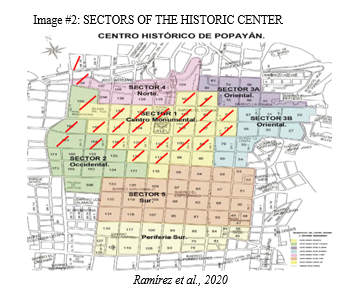
Regarding the road infrastructure, the historic center under analysis according to image #2 for the implementation of this project consists of 27 blocks, 12 streets, approximately 4,200 meters of route between the selected streets; the streets have an average width of 7 meters, and the type of demarcation is horizontal. Regarding accessibility: The main obstacles to street accessibility in the historic center of Popayán include the lack of adaptation of buildings and public spaces to ensure universal mobility, the presence of architectural barriers that hinder the movement of people with disabilities, and the need to implement regulatory actions to promote the recovery of occupied public spaces and protect those in vulnerable conditions (Financiera del desarrollo, 2019). Additionally, the importance of strengthening public spaces linking cultural heritage buildings, highlighting the historical importance of the city through public furniture, and creating spaces for permanence involving different social actors in tourism management to improve accessibility and appropriation of public space in Popayán is emphasized (Financiera del desarrollo, 2019) (Prado Erazo, 2020).
Through analysis, different aspects were identified regarding the road infrastructure of the city center of Popayán, such as the types of vehicles that move daily, average speed, most frequented roads and streets, orientation, traffic flow, and types of users. The entire road diagnosis was taken from the mobile applications Google Maps and Waze.
Below, we describe the characteristics that were analyzed on carreras 3, 4, 8, and 9; and streets 3, 4, and 5 of the historic center of Popayán.

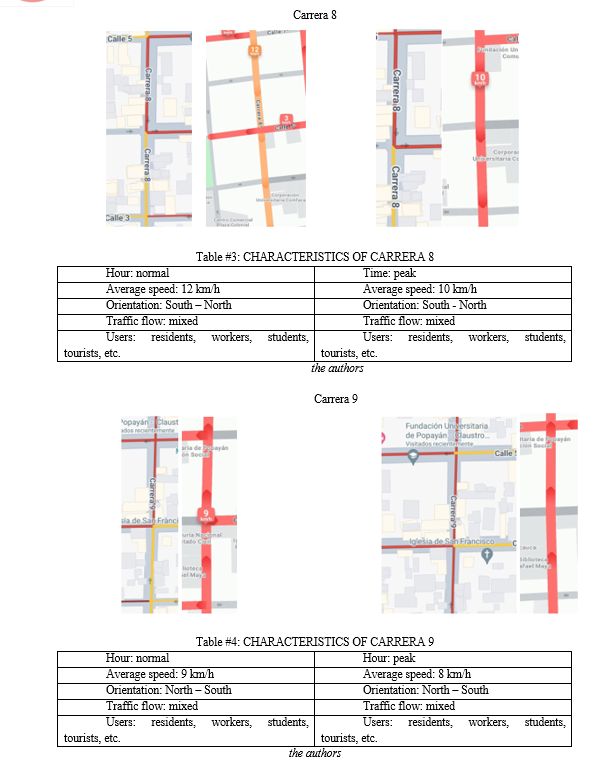
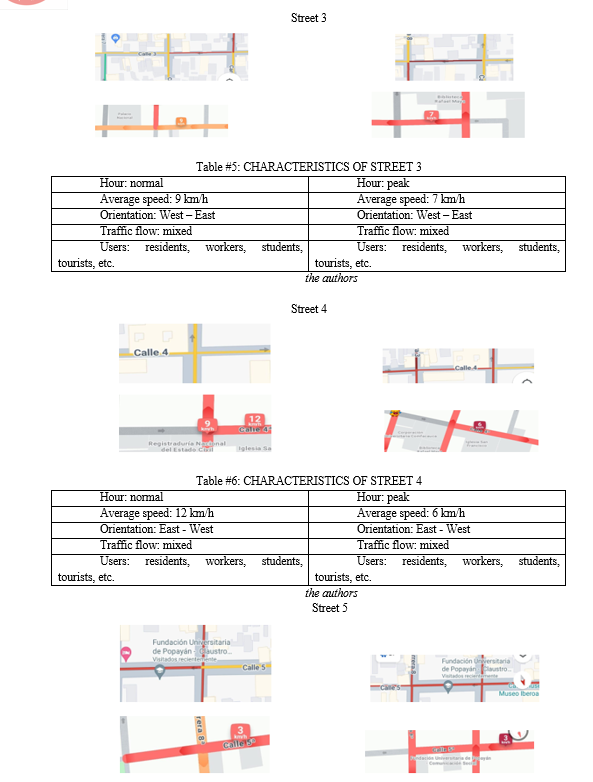
Table #7: CHARACTERISTICS OF STREET 5
|
Hour: normal |
Hour: peak |
|
Average speed: 3 km/h |
Average speed: 3 km/h |
|
Orientation: West - East |
Orientation: West - East |
|
Traffic flow: mixed |
Traffic flow: mixed |
|
Users: residents, workers, students, tourists, etc. |
Users: residents, workers, students, tourists, etc. |
the authors
Mobility in the historic center of Popayán is characterized by constant interaction among pedestrians, drivers, and passengers. An analysis of the main roads reveals that vehicular congestion persists for most of the day, intensifying during peak hours (6:30 a.m. - 8:00 a.m.; 12:00 p.m. - 2:00 p.m.; 5:00 p.m. - 7:00 p.m.) due to increased flow of people and vehicles related to the start and end of work and academic activities. Effective planning and implementation of road infrastructures are essential to improve urban mobility and reduce accident risks.
Lack of adequate planning and efficient design can exacerbate problems such as congestion, pollution, and road insecurity, negatively impacting the quality of life of city residents.
Road accidents are influenced by multiple factors, including driver behavior. Observations indicate that drivers of public and private vehicles, as well as motorcycles, often fail to respect traffic signals, such as traffic lights and stop signs, invading pedestrian spaces. This behavior reflects a lack of road awareness and education, leading to risky practices such as improper overtaking and parking in prohibited areas, thus increasing the risk of accidents (World Health Organization, 2018).
The historic center of Popayán, renowned for its historical and cultural value, attracts both tourists and residents due to its colonial architecture and the presence of educational and work institutions. This convergence generates a high pedestrian density that exceeds the capacity of the spaces intended for this purpose. As a result, pedestrians are forced to traverse areas not designed for them, such as vehicular roads, increasing the risk of accidents. This issue highlights the need for strategies to optimize pedestrian mobility and ensure road safety in the historic center.
Law 2251 of 2022 establishes the maximum and minimum speeds that vehicles of all types must adhere to on public, urban, and private roads, thereby determining that electric bicycles should not exceed the limit of 40 km/h (Domínguez Coral, 2023).
b. Traffic congestions encountered in the historic center
The population increase in Popayán over the last few decades has led to a significant rise in mobility demand, impacting the flow of vehicular traffic. This situation is exacerbated by the characteristics of the urban layout, particularly in the historic center, where narrow streets and high building density contribute to traffic congestion (Rodón Vique & Granja, 2019). Various studies suggest the implementation of strategies prioritizing public transportation in this area, including restrictions on private vehicle access as a measure to improve mobility and the quality of public space (Trujillo Ramírez et al., 2009).
3. Phase III: Design and prototyping of the most suitable solar e-carriage.
a) Choice of Energy Source
Photovoltaic solar energy, a renewable energy source with lower environmental impact than traditional electricity generation based on fossil fuels (Residuos Profesional, 2017), emerges as a viable alternative for powering electric carriages. This technology, which utilizes photovoltaic cells in solar panels to convert solar radiation into electricity (Ecoinventos green technology, 2022), requires a voltage regulation system to ensure optimal and safe operation. Voltage regulation helps prevent overcharging and excessive discharging of the e-carriage battery, ensuring system stability and prolonging battery life.
The feasibility of using solar energy to charge electric carriages depends on various interconnected factors. The efficiency and size of the solar panels, along with the amount of available solar radiation, determine the amount of energy generated for battery charging, and consequently, the vehicle's autonomy (Cárdenas Fernández & Sánchez Arques, 2020). Taking these variables into account, solar energy emerges as a sustainable alternative to fossil fuels, contributing to the reduction of pollutant emissions and the mitigation of climate change (IEA - International Energy Agency, 2024).
In this way, electric mobility through solar energy aligns with the principles of sustainable tourism, promoting the preservation of the environment and its resources.
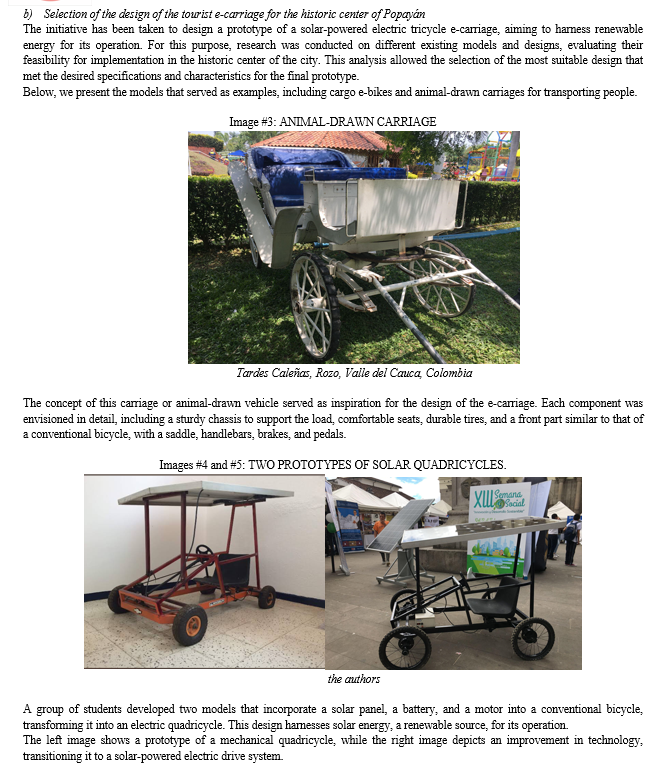
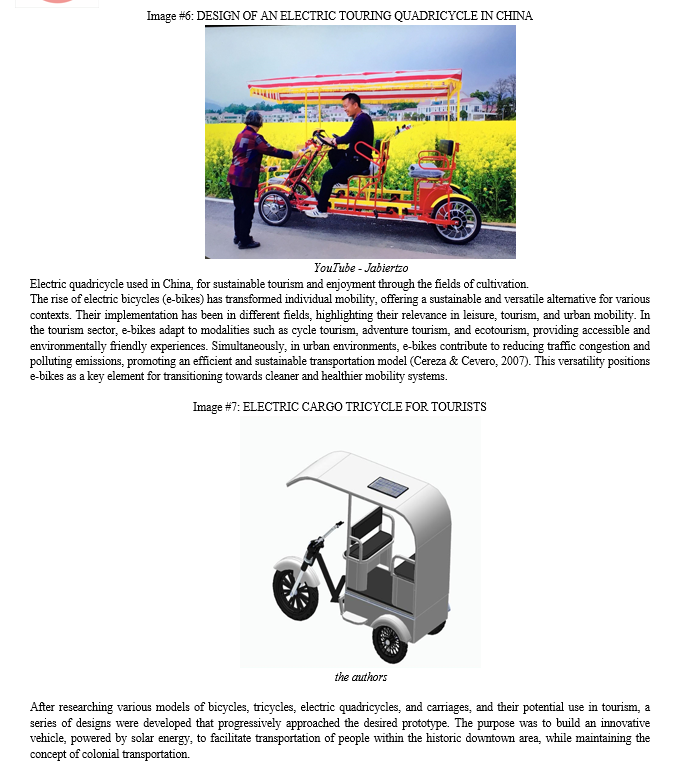
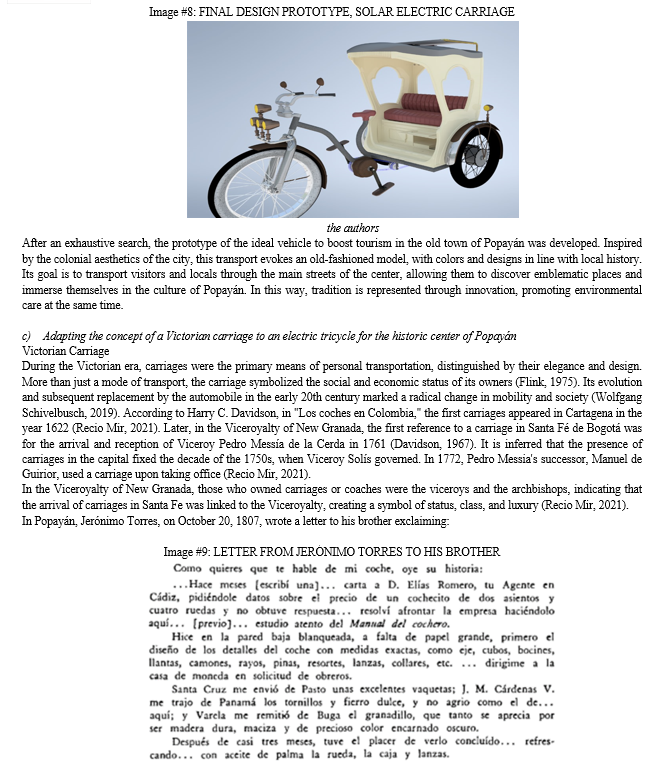
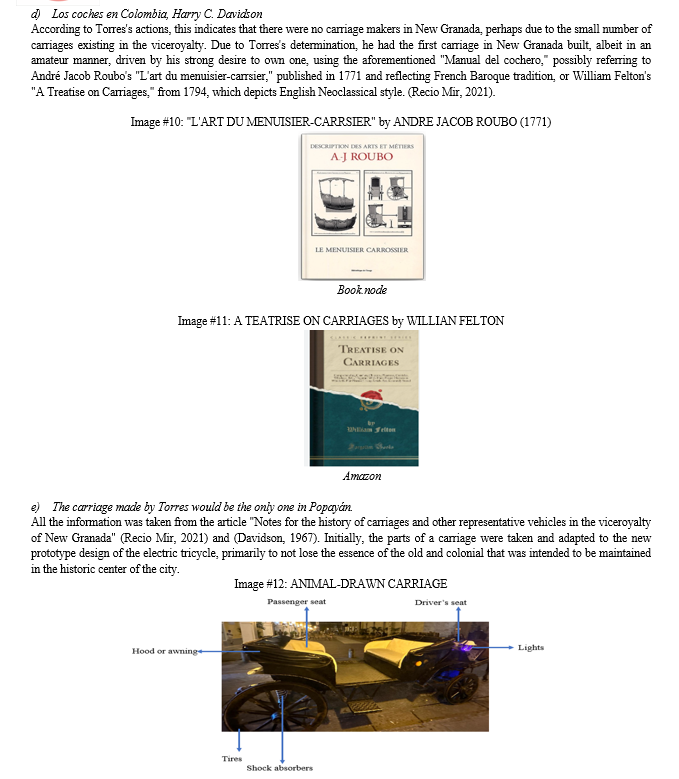
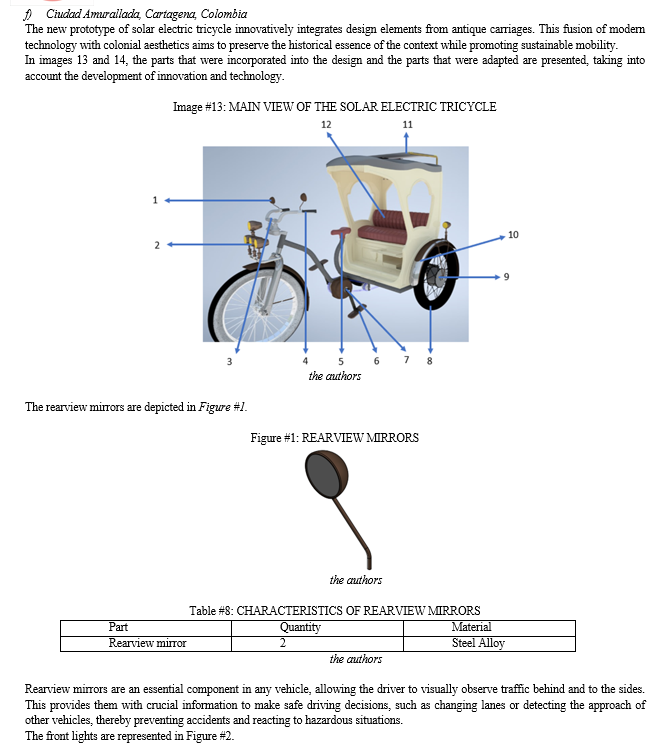
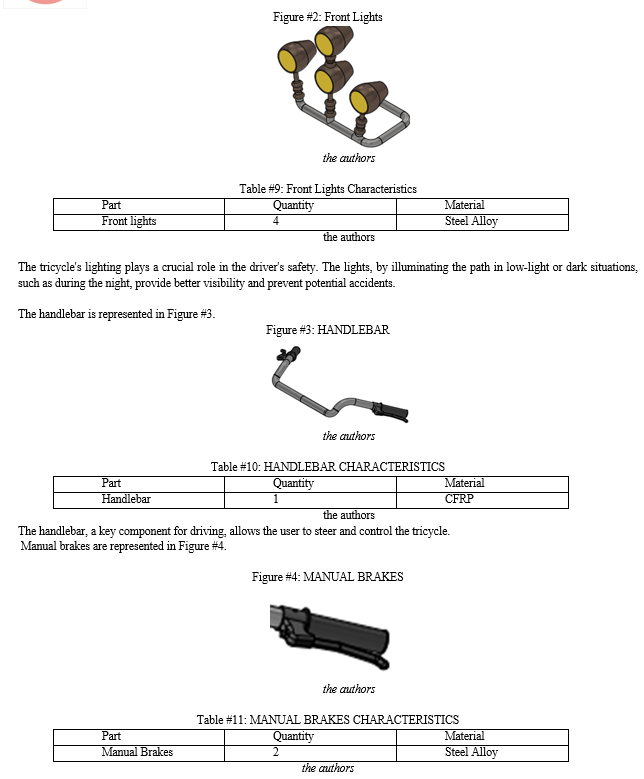

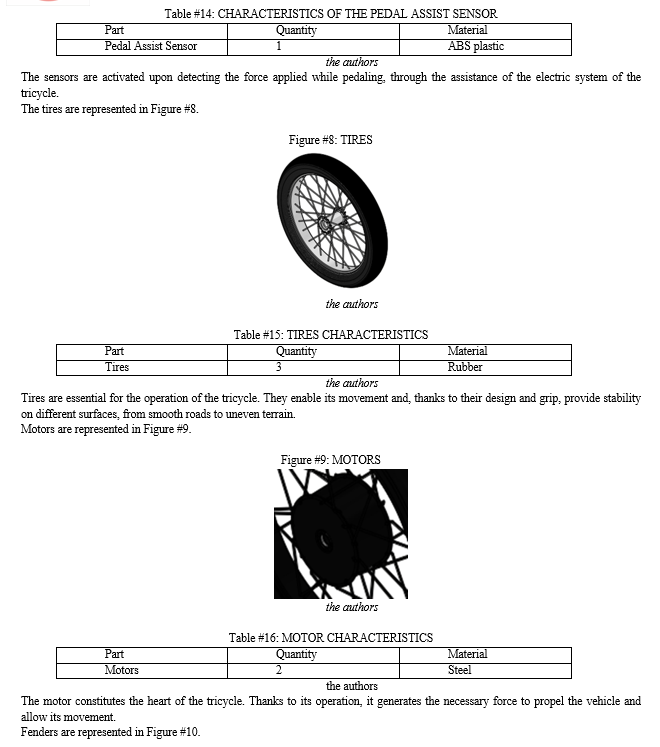
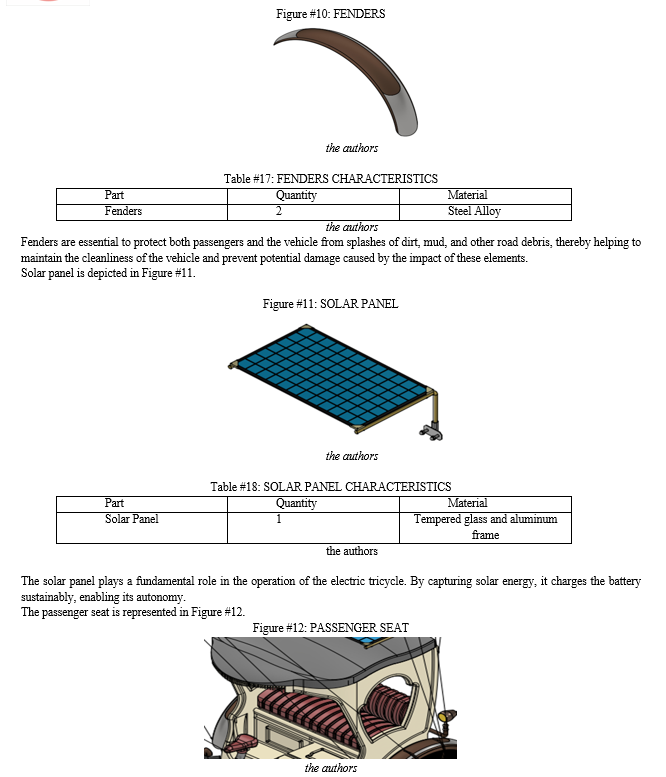

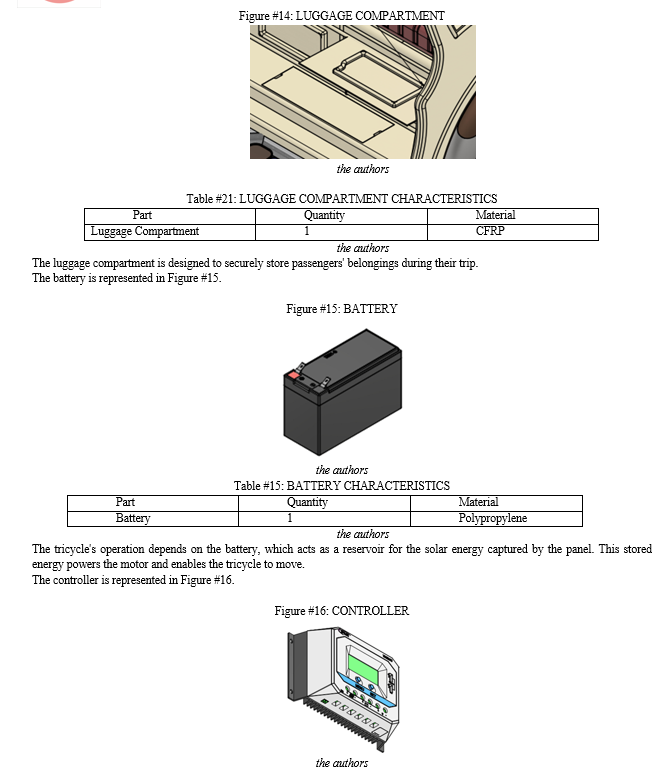
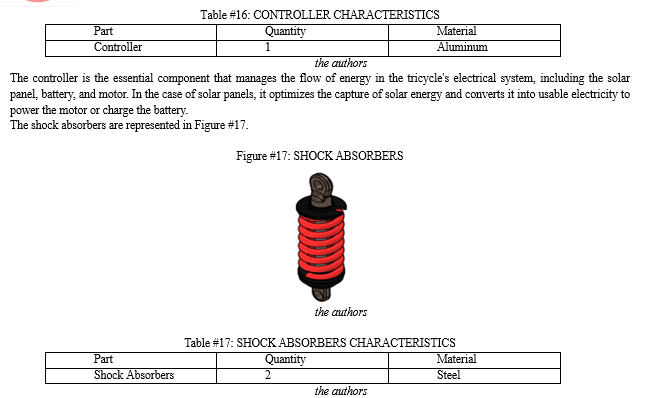
The shock absorbers are responsible for making the passengers' journey more comfortable by reducing the impact from vibrations and bumps, as they improve the stability of the tricycle.
Components of the Electric System of the Solar Electric Carriage
- Solar Panel: The direct conversion of solar energy into electricity is achieved through technological devices known as photovoltaic modules, commonly called solar panels. These modules consist of an array of individual solar cells, primarily made of silicon, a semiconductor material capable of generating electric current when exposed to solar radiation, a phenomenon known as the photovoltaic effect (Duffe & Beckman, 2013). This property of silicon and other semiconductor materials is crucial for harnessing solar energy as a renewable source of electricity, enabling the transformation of sunlight into usable electrical energy.
- Solar Charge Controller: The optimization of energy flow in photovoltaic systems relies on the intelligent management performed by solar charge controllers, electronic devices that regulate the current and voltage from the solar panels. This regulation protects the batteries from overcharging and deep discharges, extending their lifespan and improving the overall system performance (Koutroulis & Blaabjerg, 2012). By controlling the energy transfer between the panels, batteries, and loads, charge controllers ensure stable and reliable system operation.
- Battery: In the context of electric vehicles, energy storage capacity plays a fundamental role in vehicle autonomy and performance. The battery, as the primary storage component, determines the amount of energy available to power the motor and, consequently, the distance the vehicle can travel on a single charge (CC Chan, 2002). The choice of battery technology and its storage capacity are crucial factors in the design and development of efficient electric vehicles with greater autonomy.
- Electric Motor: The conversion of electrical energy into mechanical energy, enabling the movement of a variety of devices and systems, is based on the operation of electric motors. These devices, widely used in industrial applications, generate rotary or linear motion through the controlled interaction of magnetic fields (Chapman, 2021). The ability of electric motors to drive machinery, tools, appliances, and vehicles, along with their efficiency and versatility, has made them a fundamental technology for the automation of processes and the development of electromechanical systems that drive modern industry and everyday life.
The operation of the electrical system of a carriage powered by solar light
- Solar panels: They capture sunlight and convert it into direct current (DC).
- Charge controller: It regulates the current and voltage from the panels to efficiently and safely charge the batteries.
- Battery: They store the electrical energy generated by the solar panels.
- Motor: It receives alternating current from the inverter and uses it to generate motion.
Maximum speed of the electric tricycle.
Considering the maximum speeds to be maintained within the city, given that this e-carriage is used in the downtown area, the e-carriages must travel at a maximum speed determined according to the power of the motor used in its design, the one allowed and established by law in these types of areas, and the streets and avenues they traverse.
4) Phase IV: Determine the impact of the e-carriage prototype in downtown Popayán.
The electric tricycle prototype, specifically designed for tourism in Popayán, will focus on routes with the highest vehicular and pedestrian traffic. A preliminary analysis reveals that these routes, located in the monumental center of the city, host most of the tourist attractions such as museums, theaters, and historical sites. This area, frequented by both visitors and locals, presents an ideal opportunity for the implementation of the e-carriage as a sustainable and efficient mode of transportation. Therefore, specific routes have been determined, which are:

Torre del reloj - Catedral Basílica Metropolitana Nuestra Señora de la Asunción - Teatro Municipal Guillermo León Valencia - Ermita de Jesús Nazareno - Pueblito Patojo - Morro de Tulcán - Templo Santo Domingo - Puente El Humilladero - Templo San Francisco - Templo San José
The Historic Center of the city of Popayán, recognized for its architectural and historical value, has undergone a significant transformation in recent decades. Its primary function, which used to be centered around administration and housing, has given way to commercial predominance, attracting a considerable flow of pedestrians and a variety of vehicles, including public, private, freight, and even animal-drawn transportation.
This transformation poses a series of challenges in terms
- Heritage conservation: Increased traffic and commercial activity can have a negative impact on historical structures, accelerating their deterioration and complicating their maintenance.
- Mobility and safety: The coexistence of different types of vehicles and pedestrians in a space designed for a time with lower flow can generate problems of congestion, pollution, and accidents.
- Quality of life: Noise, pollution, and congestion can impact the experience of residents and visitors in the historic center.
It is essential for authorities and the community to work together to find solutions that enable sustainable development of the Historic Center of Popayán, balancing economic activity with the preservation of its valuable heritage and the quality of life of its inhabitants.
The pedestrianization of urban areas, while promoting the health and well-being of the population by encouraging walking and reducing air pollution, presents challenges regarding accessibility and handling of goods. In areas with limited parking availability, reliance on public transportation, often noisy, generates noise pollution that affects the quality of life of residents and visitors (Quintero Gonzales, 2013). To mitigate this impact, the implementation of a fleet of electric vehicles is proposed, both for transporting people with reduced mobility, such as pregnant women or the elderly, and for waste collection and supplying local businesses. This alternative would allow maintaining the tranquility of the pedestrian zone while ensuring accessibility and the efficient flow of goods and services (European Commission, 2011).
The implementation of electric vehicles in urban historic centers offers significant benefits by reducing noise pollution, thus improving the quality of life for residents, workers, and visitors. Traffic noise has been linked to a variety of health problems, including tinnitus, cardiovascular diseases such as hypertension, and increased stress hormone levels (Babisch, 2002).
By replacing internal combustion vehicles with electric alternatives, cities can create quieter and healthier environments, contributing to the reduction of these public health issues (World Health Organization, 2018). This transition to electric mobility not only promotes population well-being but also creates a more pleasant and sustainable urban environment.
a) Prevention of facade deterioration
Popayán, known as "The White City of Colombia" for its colonial architecture and the whiteness of its facades, faces progressive deterioration in its historic center. While the city is renowned for its cultural and religious heritage, expressed in its cuisine and Holy Week, vandalism, protests, unregulated advertising, and seismic movements have affected the integrity of the buildings. However, environmental pollution emerges as a determining factor in this deterioration. Constant exposure to volatile organic compounds, such as those present in fossil fuels and hydrocarbons, along with the accumulation of soot, accelerates the degradation of the facades, compromising the aesthetics and structural integrity of the city's architectural heritage (Jimenez, 1992).
Ozone (O?), a secondary pollutant present in the atmosphere, plays a crucial role in the degradation of building materials, negatively impacting built heritage and historical monuments. Its high chemical reactivity causes discoloration, surface erosion, and loss of mechanical strength in various materials, including stone, brick, mortar, and polymer. These alterations compromise both the structural integrity and aesthetics of buildings, accelerating deterioration and increasing the costs of maintenance and restoration of cultural heritage (Rodríguez Rengifo, 2022).
b) Sustainability
Sustainable engineering has become imperative in light of the growing awareness of the environmental and social impacts of technological activity. This holistic approach seeks to balance human needs, environmental responsibility, and economic viability in the design, construction, and operation of systems and processes (Adisa Azapagic, 2010). The transition to sustainability requires a paradigm shift in education and professional practice, equipping engineers to consider sustainability at every stage of the design process and decision-making (UNESCO, 2017). By incorporating these principles, engineering can contribute to a more resilient and equitable future, developing environmentally responsible technological solutions that meet human needs.
c) Reduction of Carbon Emissions
Climate change mitigation represents an urgent global challenge that demands a drastic reduction in greenhouse gas emissions, especially CO2, the main cause of global warming and its severe consequences, such as rising sea levels, extreme weather events, and biodiversity loss (Ministerio de Salud & Protección Social, 2013). Addressing this challenge requires a multidimensional approach involving individuals, businesses, and governments in the transition to a sustainable and low-carbon energy model. Individuals can contribute by adopting sustainable modes of transportation, reducing energy consumption, and choosing low-carbon diets. Businesses can implement energy efficiency strategies, invest in renewables, and optimize their supply chains (WBCSD, 2021)). At the governmental level, it is crucial to establish ambitious climate policies, promote research in clean technologies, and incentivize emission reductions (UNESCO, 2017). Collaboration among these actors is essential to achieve an effective transition to a sustainable future and combat climate change.
d) Social Innovation
According to The Young Foundation, social innovation encompasses the creation and implementation of novel ideas, whether in the form of products, services, or models, aimed at sustainably meeting social needs. This approach considers various components that converge in the pursuit of a more equitable future for all. Social innovation goes beyond merely introducing new elements; it focuses on the development and implementation of factors that contribute to tangibly and durably improving the social conditions of a population (The Young Foundation, s. f.).
It was determined that the e-carriage ST will travel at a maximum speed of 35 km/h and can be driven by either a man or a woman. The driver will need to exert force while pedaling to move approximately 764 kg without luggage or passengers, and around 900 kg with a load. The driver is expected to work approximately 12 hours daily. The route of the e-carriage depends on the stops it makes at tourist spots in the historic center and its surroundings, with each stop lasting approximately 20 to 30 minutes.
This e-carriage ST is designed with three seats: one in the front for the driver and two in the rear. It has two compartments for storing passengers' luggage and some electrical components. Additionally, it features headlights in the front and turn signals in the rear.
III. RESULTS ANALYSIS
In the construction of a solar electric carriage, the integration of an efficient electrical system is crucial for its optimal operation. The controller plays a fundamental role in this system, as it is responsible for converting alternating current (AC) into direct current (DC) and distributing it effectively to the various components of the carriage. This conversion and distribution of energy are essential for powering the motor, battery, and other electronic devices, thus ensuring the overall performance of the vehicle.
To determine the efficiency and resistance of the electric carriage (e-carriage), simulations were conducted and specific formulas were applied to the materials used in its construction. This analysis allowed for evaluating the vehicle's behavior under various conditions and determining its ability to withstand the tensions and stresses it would be subjected to during its operation.
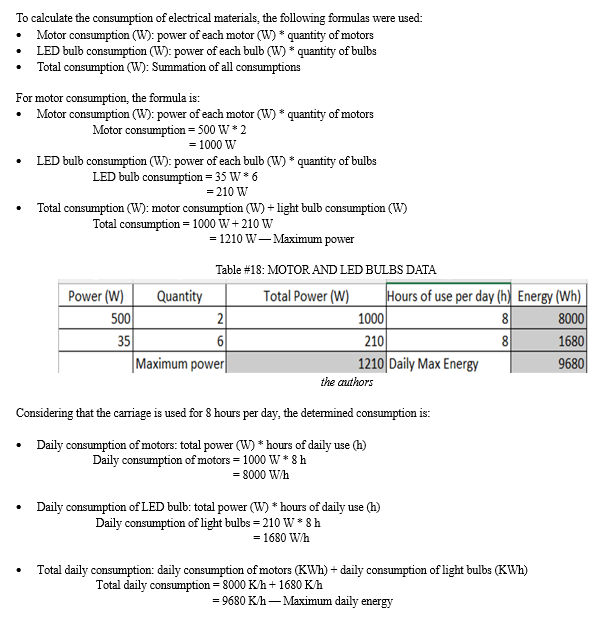
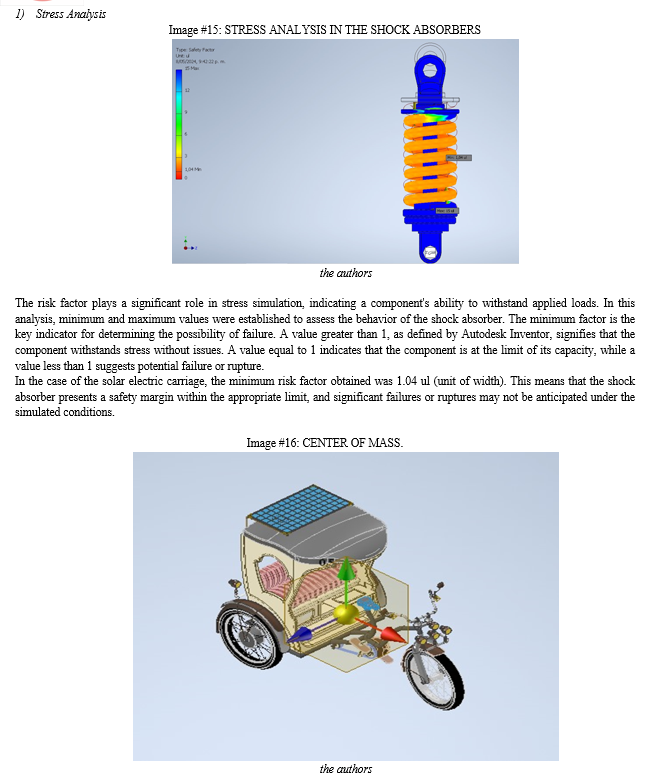
The center of mass is an imaginary point at which the weight of the object is concentrated, becoming the point of mass distribution; in the e-carriage ST, the center of gravity according to the X, Y, and Z coordinates is:
- X: The X coordinate indicates the horizontal distance from the origin of the coordinate system to the center of mass. In this case, the center of mass is located 987.473 mm to the right of the origin.
- Y: The Y coordinate indicates the vertical distance from the origin of the coordinate system to the center of mass. In this case, the center of mass is located 507.008 mm above the origin.
- Z: The Z coordinate indicates the perpendicular distance from the XY plane to the center of mass. In this case, the center of mass is located 289.036 mm above the XY plane.
Conclusion
1) Characterization of the road infrastructure: The historic center of Popayán, with narrow streets and high pedestrian density, presents mobility challenges. There is vehicular congestion, risky traffic behavior, and a lack of adequate pedestrian spaces, which increases the risk of accidents. 2) Design of the e-carriage ST prototype: A solar electric tricycle design was chosen, inspired by the city\'s colonial aesthetics. Through an integrated design and simulation approach, an e-carriage ST prototype has been designed to meet the specific needs of downtown Popayán, offering an innovative and sustainable solution for transporting people and goods in the area, with a focus on energy efficiency and reducing environmental impact. Elements from old carriages were incorporated, aiming to combine tradition and innovation. Solar energy is presented as a viable alternative for powering the vehicle. 3) Impact of the e-carriage ST prototype: The implementation of the e-carriage ST in the historic center of Popayán promises to: o Strengthening sustainable tourism: Offers an innovative and environmentally friendly tourist experience. o Reduction of carbon footprint: Decreases environmental pollution generated by conventional transportation. o Improvement of mobility: Provides an efficient and adaptable transportation alternative for the context of the historic center. o Prevention of facade deterioration: Contributes to the preservation of architectural heritage by reducing pollution. o Social innovation: Promotes a more equitable and accessible transportation model. Overall, the study supports the proposed hypothesis, indicating that the e-carriage ST has the potential to strengthen sustainable tourism in the historic center of Popayán. The prototype, with its design adapted to the cultural context and its focus on sustainability, is presented as an innovative solution to the mobility and heritage preservation challenges in the city.
References
[1] Adisa Azapagic, S. P. (2010). Sustainable Development in Practice: Case Studies for Engineers and Scientists. https://onlinelibrary.wiley.com/doi/book/10.1002/9780470972847 [2] Alcaldía de Popayán. (2024). Programación Semana Santa. https://popayan.gov.co/SecretariasyEntidades/Turismo/SaladePrensa/Paginas/Programaci%C3%B3n-Semana-Santa-2024.aspx#gsc.tab=0 [3] Babisch, W. (2002). El concepto de ruido/estrés, evaluación de riesgos y necesidades de investigación. https://pubmed.ncbi.nlm.nih.gov/12537836/ [4] Barcelona cat. (s. f.). Semana Santa 2023: Del domingo 2 al lunes 10 de abril. www.barcelona.cat. https://www.barcelona.cat/culturapopular/es/fiestas-y-tradiciones/semana-santa [5] Bravo Molina, C. R. (2012). Centro histórico de Popayán. Revista trazos. https://fup.edu.co/?r3d=trazsos-6 [6] Cohen Cárdenas, E. J. C. (2017). ALTERNATIVAS DE MOVILIDAD SOSTENIBLE EN CENTROS HISTORICOS DE CIUDADES DE TAMAÑO INTERMEDIO-CASO DE ESTUDIO, SINCELEJO, COLOMBIA. https://manglar.uninorte.edu.co/bitstream/handle/10584/8140/132751.pdf?sequence=1 [7] Concejo municipal de Popayán. (2006). 11 ACUERDO 07 2002 CENTRO HISTORICO.doc. https://repositoriocdim.esap.edu.co/bitstream/handle/123456789/10967/5900-2.pdf?sequence=2 [8] Corporación gastronómica de Popayán. (s. f.). XXII Congreso Gastronómico de Popayán. https://gastronomico.org.co/ [9] Davidson, H. C. (1967). Los coches en Colombia. https://cvc.cervantes.es/lengua/thesaurus/pdf/22/TH_22_003_114_0.pdf [10] Domínguez Coral, L. A. (2023, mayo 12). Estos son los límites de velocidad en Colombia. https://www.eltiempo.com/economia/sectores/cuales-son-los-limites-de-velocidad-permitidos-en-colombia-segun-la-ley-767949 [11] Duffe, J. A., & Beckman, W. A. (2013). Solar Engineering of Thermal Processes. https://books.google.com.co/books/about/Solar_Engineering_of_Thermal_Processes.html?id=5uDdUfMgXYQC&redir_esc=y [12] Ecoinventos green technology. (2022). Paneles fotovoltaicos: Qué son, cómo funcionan, para qué sirven. https://ecoinventos.com/paneles-fotovoltaicos/ [13] European Commission. (2011). Hoja de ruta hacia un espacio único europeo de transporte: Por una política de transportes competitiva y sostenible. https://eur-lex.europa.eu/legal-content/ES/TXT/PDF/?uri=CELEX:52011DC0144 [14] Fajardo, H. C. L., C. L., & Gómez, S. A. M, A. M. (2015). Análisis de la elección modal de transporte público y privado en la ciudad de Popayán. Territorios, 17(33), 157-190. https://doi.org/10.12804/territ33.2015.07 [15] Financiera del desarrollo. (2019). PLAN MAESTRO DE ESPACIO PÚBLICO DE POPAYÁN (Ejecutivo 06). https://www.findeter.gov.co/system/files/convocatorias/PAF-MALECONPOPAYAN-C-013-2021/anexo_tecnico_plan_maestro_de_espacio_publico_de_popayan.pdf [16] Flink, J. J. (1975). The Car Culture. MIT Press. https://www.cambridge.org/core/journals/business-history-review/article/abs/car-culture-by-james-j-flink-cambridge-mass-mit-press-1975-pp-x-260-1495/A7D12AEB631832770F4C8A3C69CF8C17 [17] IEA - International Energy Agency. (2024). Renewables 2023. https://iea.blob.core.windows.net/assets/96d66a8b-d502-476b-ba9454ffda84cf72/Renewables_2023.pdf [18] Jimenez, C. S. (1992, mayo 7). Deposition of airborne organic pollutants on historic buildings. https://www.sciencedirect.com/science/article/abs/pii/095712729390047A?via%3Dihub [19] Koutroulis, E., & Blaabjerg, F. (2012). Una nueva técnica para rastrear el punto de máxima potencia global de conjuntos fotovoltaicos que funcionan en condiciones de sombra parcial. DOI: 10.1109/JPHOTOV.2012.2183578 [20] Ministerio de Salud, & Protección Social. (2013). Cambio Climático. https://www.minsalud.gov.co/sites/rid/Lists/BibliotecaDigital/RIDE/VS/PP/SA/abece-cambio-climatico-abril-2023.pdf?ID=26982 [21] Montes Ochoa, J. V. (2023). EVOLUCIÓN E IMPACTO DE LOS VEHÍCULOS ELÉCTRICOS DEL SECTOR PRIVADO EN BOGOTÁ. http://hdl.handle.net/10882/12662 [22] Moreno, M., & Coromoto, M. (2010). Turismo y producto turístico. https://www.redalyc.org/pdf/4655/465545890011.pdf [23] Prado Erazo, R. J. (2020). Consideraciones Arquitectónicas para la Movilidad Universal en Edificaciones Patrimoniales de la ciudad de Popayán. Estudio de caso: La Alcaldía de Popayán. https://unividafup.edu.co/repositorio/items/show/136 [24] Quintero Gonzales, J. R. (2013, febrero 13). EL RUIDO DEL TRÁFICO VEHICULAR Y SUS EFECTOS EN EL ENTORNO URBANO Y LA SALUD HUMANA. https://repository.upb.edu.co/handle/20.500.11912/7797 [25] Recio Mir, Á. (2021). Apuntes para la historia de los carruajes y otros vehículos representativos en el virreinato de Nueva Granada. 26(2). https://doi.org/10.22380/20274688.1520 [26] Residuos Profesional. (2017). Las plantas de producción de energía eléctrica a partir de la combustión de carbón son las máximas responsables de los principales contaminantes liberados al aire, según un informe de la Agencia Europea de Medio Ambiente (EEA) [Noticia]. https://www.residuosprofesional.com/electricas-carbon-industria-contaminante/#:~:text=Las%20plantas%20de%20producci%C3%B3n%20de,de%20Medio%20Ambiente%20(EEA) [27] Rodón Vique, D. M., & Granja, D. M. (2019). RECOMENDACIONES DE DISEÑO URBANO Y CULTURA CIUDADANA EN INTERSECCIONES CRITICAS, PARA MEJORAR LA MOVILIDAD EN BICICLETA DE LA CIUDAD DE POPAYÁN – CAUCA. https://unividafup.edu.co/repositorio/items/show/251 [28] Rodríguez Rengifo, S. (2022). Efecto del ozono troposférico en los materiales de construcción. https://acofipapers.org/index.php/eiei/article/view/2265/1843 [29] The Young Foundation. (s. f.). Innovación social [Empresarial]. The Young Foundation. https://youngfoundation.org/social-innovation/ [30] Trujillo Ramírez, R., Bermúdez, D., Longo, M., & Benavidez, F. (2009). Sistema integral de transporte público en Popayán departamento del Cauca Análisis prospectivo [Universidad Nacional Abierta y a Distancia UNAD]. https://repository.unad.edu.co/handle/10596/1303 [31] Latorre Ulloa, K. (2012). Diseño de un vehículo de transporte urbano para distancias cortas, como modelo de innovación social para el mejoramiento de la calidad de vida. https://repository.javeriana.edu.co/handle/10554/16228 [32] Ministerio de Salud, & Protección Social. (2013). Cambio Climático. https://www.minsalud.gov.co/sites/rid/Lists/BibliotecaDigital/RIDE/VS/PP/SA/abece-cambio-climatico-abril-2023.pdf?ID=26982 [33] Montes Ochoa, J. V. (2023). EVOLUCIÓN E IMPACTO DE LOS VEHÍCULOS ELÉCTRICOS DEL SECTOR PRIVADO EN BOGOTÁ. http://hdl.handle.net/10882/12662 [34] Moreno, M., & Coromoto, M. (2010). Turismo y producto turístico. https://www.redalyc.org/pdf/4655/465545890011.pdf [35] Prado Erazo, R. J. (2020). Consideraciones Arquitectónicas para la Movilidad Universal en Edificaciones Patrimoniales de la ciudad de Popayán. Estudio de caso: La Alcaldía de Popayán. https://unividafup.edu.co/repositorio/items/show/136 [36] Quintero Gonzales, J. R. (2013, febrero 13). EL RUIDO DEL TRÁFICO VEHICULAR Y SUS EFECTOS EN EL ENTORNO URBANO Y LA SALUD HUMANA. https://repository.upb.edu.co/handle/20.500.11912/7797 [37] Recio Mir, Á. (2021). Apuntes para la historia de los carruajes y otros vehículos representativos en el virreinato de Nueva Granada. 26(2). https://doi.org/10.22380/20274688.1520 [38] Residuos Profesional. (2017). Las plantas de producción de energía eléctrica a partir de la combustión de carbón son las máximas responsables de los principales contaminantes liberados al aire, según un informe de la Agencia Europea de Medio Ambiente (EEA) [Noticia]. https://www.residuosprofesional.com/electricas-carbon-industria-contaminante/#:~:text=Las%20plantas%20de%20producci%C3%B3n%20de,de%20Medio%20Ambiente%20(EEA) [39] Rodón Vique, D. M., & Granja, D. M. (2019). recomendaciones de diseño urbano y cultura ciudadana en intersecciones críticas, para mejorar la movilidad en bicicleta de la ciudad de Popayán – cauca. https://unividafup.edu.co/repositorio/items/show/251 [40] Rodríguez Rengifo, S. (2022). Efecto del ozono troposférico en los materiales de construcción. https://acofipapers.org/index.php/eiei/article/view/2265/1843 [41] The Young Foundation. (s. f.). Innovación social [Empresarial]. The Young Foundation. https://youngfoundation.org/social-innovation/ [42] Trujillo Ramírez, R., Bermúdez, D., Longo, M., & Benavidez, F. (2009). Sistema integral de transporte público en Popayán departamento del Cauca Análisis prospectivo [Universidad Nacional Abierta y a Distancia UNAD]. https://repository.unad.edu.co/handle/10596/1303 [43] UNESCO. (2009). Las procesiones de Semana Santa de Popayán. Unesco Patrimonio Cultural Inmaterial. https://ich.unesco.org/es/RL/las-procesiones-de-semana-santa-de-popayan-00259 [44] UNESCO. (2017). Education for Sustainable Development Goals: Learning objectives. https://unesdoc.unesco.org/ark:/48223/pf0000247444 [45] Urzúa M, A., & Caqueo-Urízar, A. (2012). Calidad de vida: Una revisión teórica del concepto. Terapia psicológica, 30(1), 61-71. https://doi.org/10.4067/S0718-48082012000100006 [46] Valdés, J. R. M. (2021). Biotecnología ambiental de los combustibles fósiles. https://doi.org/10.13140/RG.2.2.11417.34401 [47] WBCSD. (2021). Visión 2025 es hora de Transformar. https://www.wbcsd.org/download/file/13198 [48] Wolfgang Schivelbusch. (2019). The Railway Journey. https://www.degruyter.com/document/doi/10.1525/9780520957909/html [49] World Health Organization. (2018). Environmental noise guidelines for the European Region. https://www.who.int/europe/publications/i/item/9789289053563 [50] World Health Organization. (2018). Global status report on road safety 2018. World Health Organization. https://iris.who.int/handle/10665/276462
Copyright
Copyright © 2024 Ana Maria Jimenez Santos, Katty Yohana Valencia Solis, Richard Marcelo Imbachi Chavez. This is an open access article distributed under the Creative Commons Attribution License, which permits unrestricted use, distribution, and reproduction in any medium, provided the original work is properly cited.

Download Paper
Paper Id : IJRASET62133
Publish Date : 2024-05-15
ISSN : 2321-9653
Publisher Name : IJRASET
DOI Link : Click Here
 Submit Paper Online
Submit Paper Online

